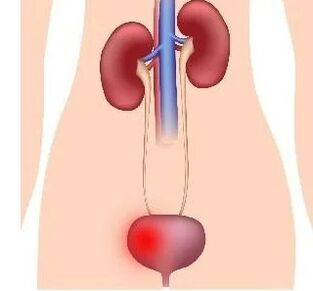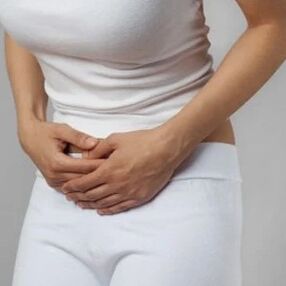Cystitis- This is a pathology characterized by the development of an inflammatory process that influences the wall of the bladder as a result of the effects of bacterial microorganisms.

Statistical cystitis- one of the most common urological pathologies. Due to their morphophysiological characteristics, women are much more predisposed to the occurrence of this inflammation.
Bacterial agents that enter the bladder cavity is possible in three types:
- The rising path- through the urethra (urethra). The main task in this version of the penetration of microorganisms is one of the anatomical and morphological characteristics of the female urinary tract: a short and wide urethra, which has been closely dispensed with with the anus and the vagina.
- Downward- from the kidneys. This option develops as a kidney inflammation process, such as chronic pyelonephritis.
- Hematogenic path- The rarest option is determined if the combination is determined immediately according to infectious diseases or if another source of a purulent infection is determined in the female body. There is also a probability of a bacterial microflora in the bladder due to the presence of anatomical anastomoses (compounds) between the lymphatic vessels of the genital organs and the bladder, which are subject to inflammatory changes in the above.
The most common cause of the inflammatory process of the bladder is the E. coli (in 4 of 5 cases associated with the anatomical and morphological properties mentioned above and the presence of this microflora in the intestine).
Less often, aperture is associated with staphylococcal, streptococcal and enterococcal microorganisms. Gram -negative sticks cause inflammation of the bladder due to instrumental and surgical interventions.
The incidence of cystitis in connection with mushroom microorganisms, the simplest and viruses has increased recently.
Only the introduction of infectious microorganisms is not enough to develop a complete inflammatory reaction in the bladder, since the body contains resistance mechanisms for the effect of pathogenic flora.
Cystitis development factors
Therefore in addition to the etiological factor of factors such as ::
- Disorder of hemodynamic function(Blood circulation) of the pelvic organs and especially the bladder;
- Disorder of the elimination function of the bladder(Stagnation of urine);
- Inhibition of different immune compounds of the body(Lack of vitamins, exposure to low temperatures, stress, increased tiredness, etc. );
- Passionate effects of biochemical agentsand exchange products that are released in the urine to the structure of the wall of the bladder;
- Exposure to radiological rays;
- Non -observance with hygieneExternal genitals and random sexual intercourse;
- Pathology of the stomach intestine tractIn the presence in which the microflora accumulates and increases its activity, which then goes into the urinary tract;
- Regular changes in the hormonal metabolismThis leads to the lack of tone of the urethra and creates the best infection conditions.

The first symptomatic manifestations of cystitis in women
The clinic of acute cystitis in a woman is characterized by a sudden start and a pronounced symptom complexWith:
- The occurrence of frequent urination (Pollakiuria)which is characterized by a frequency at least every 60 minutes and small volumes of the released urine; With the development of frequent imperative hits, patients cannot control and maintain the urine.
- Dysuria (injury to urination)Accompanied by pain in the hypogastric region (in the lower abdomen). With the development of the degree of inflammatory process in the wall of the bladder, these symptoms develop: the more it is developed, the more often the urge to urinate and the more intense pain;
- Itching in the urinary tractdevelop during urination. Develops due to the exposure to the mucous membranes of the urinary tract products of metabolism of microorganisms that caused inflammatory bladder infections;
- The appearance of blood dropsAt the end of the urine law;
- The appearance of the clouding of the urineDue to the shooting of a large number of blood cells (leukocytes and red blood cells), bacterial microflora, cells of the surface pithel of the inner wall of the bladder;
- Such patients are not characterized by a change in the general state.The temperature indicators for patients are characterized by normal or slightly increased (low gradu) numbers. Scientists associate this with the fact that the mucous membrane of the bladder practically does not absorb the metabolic products of microorganisms, which, after entering the blood, usually lead to poisoning the body and the development of characteristic symptoms of inflammation.
The connection of the sudden symptoms and the previous hypothermia of the body of the woman that has appeared. Phenomena acute inflammation can sometimes be observed for 2-3 days and disappear regardless of therapy.

Most of the time, this process usually takes more than 6 days, sometimes up to 15 days. The presence of an illness later requires the appointment of the therapy the appointment of additional examination methods in order to identify the simultaneous pathologies of the body.
Characterization of pain in bladder infection in women
A different severity of pain syndrome is observed in patients with acute cystitis:
- In the slight course of the inflammatory process, the patients feel insignificant and painful in the lower abdomen.The moderate Pollakiuria accompany sensitive pain at the end of the urine law. With the further development of the inflammatory process, the intensity of the pain increases. This syndrome then accompanies the beginning or the whole act of urinating. The pain in nothing is not connected to the action and acquire almost constant in nature, it is accompanied by very painful palpation through the projection of the bladder.
- In a situation in which severe bladder infection developedPatients have to urinate at least 2-3 times an hour, which is accompanied by significant pain syndrome and the occurrence of a blood discharge from the urethra at the end of the law. Pain significantly worsens the quality of the patient's life because they do not disappear every day.
The presence of blood cells and blood in urine with cystitis (hematuria syndrome)
If an inflammatory process develops in the walls of the bladder, it affects the fabric areas near the confluence of the ureter and the urethra output. The fabric becomes loose and bleeding.
This can be seen through the occurrence of micro and macrohematuria (or blood) in the urine, which is often observed at the end of the urination law (terminal hematuria).
One of the heaviest forms of acute cystitis is hemorrhagic. This type of inflammation occurs with a significant penetration of the red blood cells (red blood cells) from the bloodstream of the nutritious arteries into the bladder cavity.
This option is possible with an increased permeability of the walls of blood vessels (condition for anemia, lack of vitamins, diseases in the operation of the blood system) or damage to the above walls with bacterial cells (normally streptococcal flora). The red blood cells that fell into the bladder cavity dye urine in the bloodstone.
When hematuria occurs, the doctor is obliged to carefully carry out the differential diagnosis between acute cystitis and complicated acute form - hemorrhagic cystitis. For this purpose, additional examination methods are prescribed, the type of lesion is clarified and the correct therapy scheme is selected.
Characteristics of acute and chronic cystitis in women
Sharp cystitis
If you summarize the above information, you can distinguish the strong start of the disease and the presence of a certain symptom complex for acute aperture inflammation:
- Frequent urination in small portions,
- Pain syndrome of different nature,
- Itching that is connected to the urine,
- The appearance of blood falls at the end of the plot,
- The unchanged general condition of the woman.
In the event of a real and timely diagnosis, the pathological state is healed within 6 to 10 days. In the absence of improvements according to the 15th day of the course of the disease, it is worth thinking about chronization of inflammatory changes.

In addition to hemorrhagically, there are two other forms of complicated course of acute cystitis:
- Gangrenous.The gang -redous shape is rarely found and occurs due to an impaired blood supply or the innovation of the bladder. Clinically, such a heyday manifests itself in difficulties accompanied by pain, high body temperature, pain in the sacral area. The process is extremely dangerous for the development of impressive complications such as peritonitis and requires the quick use of measures for treatment.
- Phlegmonous.The phlegmonous shape is shown by significant poisoning of the body, a high body temperature and is accompanied by the release of a small amount of urine (oliguria). The urine with such a complicated current receives a lazy smell, a muddy character, flakes of fibrinformations, blood binge.
The duration of the pathology course in the event of the development of complicated forms increases significantly.
There is another form of cystitis - interstitial.It is characterized by inflammation of all urine bladder membranes. The clinic is dominated by a sharply rapid urination, which is reached up to 180 times a day, active complaints about severe pain in the Hypogastr region when filling the bladder and its regression after the urine law. The capacity of the bladder is significantly reduced, with the symptoms mentioned above.
Chronic cystitis
In contrast to acute, chronic cystitis rarely occurs as primary pathology and in most cases is a secondary complication of the course of existing pathologies of the bladder, kidneys, urethra.
In view of this fact, it is necessary to carefully examine the body for the presence of the above pathological changes and to exclude or confirm the specific origin of microorganisms - tuberculosis stick, invasion of Trichomonas.
Clinically, the chronic flowering period manifests itself either by a continuous course with moderate differences in the symptoms and the clinical analysis of urine or in the form of a recurring pathology with periods of deterioration (similar to the clinic of acute cystitis) and full regression (without manifestations of the pathological process).
Thus, the objective manifestations of chronic cystitis correspond to the acute process. They correlate with the common protective properties of the body, the etiology of a bacterial agent that caused an infectious process and the severity of inflammation. Pain, frequent urination, itching, the presence of blood and the falsification of the urine are less pronounced with constant course and correspond to the acute process with the recurrent course of chronic cystitis.
Due to the lesion of the inflammatory reaction of the mucous membrane, the edema of all layers of the urinated wall and the increase in the intrapacear pressure generated all conditions for the formation of vesicular memorial reflux, i. e. H. cast fluid from the bladder back into the ureter (connects the kidneys and blisters).

The doctor-urologist is involved in reviewing the diagnosis and the purpose of therapy against cystitis.
In order to correctly diagnose the inflammatory pathology, it is necessary to clearly remedy the patient's symptoms and their history (which preceded the development of pathology).
Clinical manifestations are very specific and can immediately point out the presence of this disease. However, it is necessary to carefully carry out the differential diagnosis between all types of cystitis and other pathologies of the bladder and diseases of the abdominal organs.
From the anamnesis, data on the loads and influences of low temperatures, the lesions and other lesions localized in the pelvic organs and the genitarian system will be useful.
After clarifying symptoms and anamnesis, the clinical (general) urine analysis can help check the diagnosis - increased values of white and red blood cells are detected (leukocytes or red blood cells).
In order to identify the type of bacterial microorganism that caused the inflammatory process, the urine saw special nutrient media that can be used in the future to choose the most effective antibacterial medicine.
Before the urine's urine for the bacteriological examination, it is necessary to treat the area of external genitals qualitatively with an antiseptic solution. The implementation of cystoscopy in the presence of an acute inflammatory reaction is contraindicated.
Cystoscopy during remission helps to diagnose a chronic aperture composition together with the collection of symptoms and data on anamnesis. This determines all the necessary features of an inflammatory disease. With this manipulation it is possible to take biopsy material-die urine bubble mucous membranes. In order to identify chronic bladder infection, an X beam study with contrast is also recommended.


























